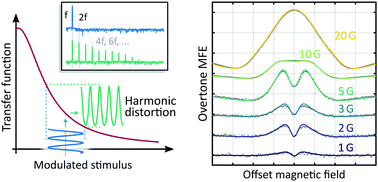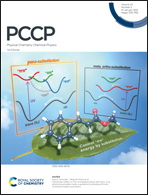Development of lock-in based overtone modulated MARY spectroscopy for detection of weak magnetic field effects†
Abstract
Modulated magnetically altered reaction yield (ModMARY) spectroscopy is a derivative variant of fluorescence detected magnetic field effect measurement, where the applied magnetic field has both a constant and a modulated component. As in many derivative spectroscopy techniques, the signal to noise ratio scales with the magnitude of the modulation. High modulation amplitudes, however, distort the signal and can obscure small features of the measured spectrum. In order to detect weak magnetic field effects (including the low field effect) a balance of the two has to be found. In this work we look in depth at the origin of the distortion of the MARY signal by field modulation. We then present an overtone detection scheme, as well as a data analysis method which allows for correct fitting of both harmonic and overtone signals of the modulation broadened MARY data. This allows us to robustly reconstruct the underlying MARY curve at different modulation depths. To illustrate the usefulness of the technique, we show measurements and analysis of a well known magnetosensitive system of pyrene/1,3-dicyanobenzene (Py/DCB). The measurements of first (h1) and second (h2) harmonic spectra are performed at different modulation depths for both natural isotopic abundance (PyH10), and perdeuterated (PyD10) pyrene samples.



 Please wait while we load your content...
Please wait while we load your content...
